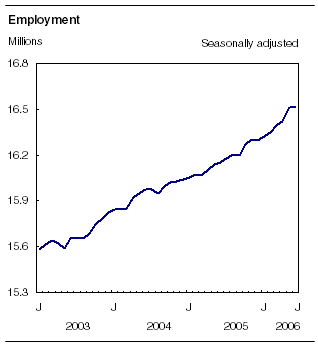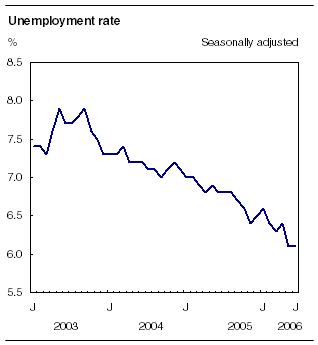
















 |
|
 |                |
Information identified as archived is provided for reference, research or recordkeeping purposes. It is not subject to the Government of Canada Web Standards and has not been altered or updated since it was archived. Please "contact us" to request a format other than those available.

|

Friday, July 7, 2006 Labour Force Survey
Following large gains the previous month, employment was little changed in June, leaving the unemployment rate at a 32-year low of 6.1%. Since the start of the year, employment is up 1.3% or 216,000, more than double the growth of the first half of 2005. 
Employment was unchanged in June in almost all provinces. However, there has been strong growth in the first six months of the year in some parts of the country. Leading the way is Alberta, with an increase of 3.9% since January 2006 — a growth rate three times the national average. Saskatchewan and Ontario have also had above-average growth.
There were solid gains in health care and social assistance in June. This increase continues an upward trend that began at the start of this year, particularly in British Columbia, Alberta and Ontario. Employment in construction, however, pulled back in June. In the first six months of 2006, there have been above-average employment gains in a number of industries, namely, finance, insurance, real estate and leasing (+6.3%); health care and social assistance (+5.4%); natural resources (+5.2%) and "other services" (+4.2%). Declines in full-time employment in June offset increases in part time, mostly among youths and adult men. Following strong gains since March of this year, employment was flat for adult women in June. There were large gains in the number of private sector employees in June, but at the same time there were losses in self-employment and in the public sector. So far this year, the number of employees in the private sector has jumped 2.4%, well ahead of gains in the public sector (+1.7%). Self-employment, meanwhile, has fallen by 3.7%. This has been the most significant period of decline in self-employment since 2002, with losses across a number of industries. Average hourly wages were up 3.5% from June of last year, remaining above the most recent year-over-year increase of 2.8% in the Consumer Price Index. Wage growth continues to be strong in Alberta, jumping 7.3% from a year ago. 
Large gain in health care and social assistanceEmployment increased by an estimated 41,000 in health care and social assistance in June, mostly in Ontario and Quebec. This brings gains in this industry to 94,000 (+5.4%) since the beginning of the year, after little growth in both 2004 and 2005. Since the start of this year, growth in this industry was particularly strong in hospitals, child day care services and individual and family services. Construction, on the other hand, fell by 19,000 in June. After strong growth in the preceeding two years, employment in this industry is unchanged from the start of 2006. Although little changed in June, employment in manufacturing has declined by 8.5% (-199,000) since the end of 2002. So far in 2006, the declines have been in food, paper and textile manufacturing. Alberta leads employment growth in 2006Employment growth in Alberta paused in June, following large gains in the previous month. Since the start of the year, employment has grown by 3.9% (+69,000), three times the national average. Over the first half of the year, industry gains have been in natural resources, public administration and health care and social assistance. Employment in Saskatchewan edged up by 2,000 in June, mainly in accommodation and food services. This brings the province's employment rate of 65.5% and the participation rate of 68.9% to record highs. In the last six months, Saskatchewan has experienced the second highest rate of employment growth of all provinces (+1.9%). Gains so far this year have been in trade; agriculture; accommodation and food services and construction. Employment fell in both Nova Scotia (-5,000) and Prince Edward Island (-1,000) in June. These declines leave employment in both provinces at the same level as in December 2005. In June, employment was unchanged in both Ontario and Quebec. So far this year, employment is up 1.4% in Ontario, but only 0.4% in Quebec. While manufacturing has been weak in both provinces, the offsetting effects from gains in the service sector have been stronger in Ontario. In British Columbia, fewer people were searching for work in June, bringing the unemployment rate to another record low of 4.3%. Employment has grown 1.1% in the first six months of 2006, somewhat slower than during the same span a year earlier (+1.5%). Like in British Columbia, Manitoba's unemployment rate declined in June to an all-time low (3.6%), as fewer people participated in the labour market. Since the start of the year, employment in Manitoba has grown at a slightly slower rate (+0.8%) than the national average. Full-time declines offset part-time gainsA drop in full-time employment (-67,000) along with a similar jump in part-time (+63,000) left overall employment unchanged in June. In the last three years, the bulk of the employment growth has been full time (+6.4%). There was little change in employment in June among adult men and women as well as youths. However, since the start of the year, growth has been strongest for adult women (+2.1%), followed by youths (+1.5%) and adult men (+0.6%). Summer employment promising for younger studentsA greater share of students aged 17 to 19 years were employed in June (58.2%), up 4.7 percentage points from June of last year and the highest employment rate for this group in 16 years. However, the employment rate for older students aged 20 to 24 was similar to a year earlier at 69.7%, but remains well below the all-time high reached in June 1989 (79.7%). Note: From May to August, the Labour Force Survey collects labour market information about people aged 15 to 24 years who were attending school full-time in March and intending to return to school in the fall. Survey results for May and June give an early indication of the summer job market for older students aged 20 to 24, however, many students aged 15 to 19 are not yet out of school for the summer. Survey results for July and August will provide further insight into the summer job market. The published estimates are not seasonally adjusted, therefore comparisons can only be made on a year-over-year basis. Available on CANSIM: tables 282-0001 to 282-0042, 282-0047 to 282-0064 and 282-0069 to 282-0099. Definitions, data sources and methods: survey number 3701. Available at 7:00 a.m. on Statistics Canada's website. From the home page, choose Today's news releases from The Daily, then Latest Labour Force Survey. A more detailed summary, Labour Force Information, is available today for the week ending 17 June (71-001-XIE, free) from the Our Products and Services page of our website. The 2005 Labour Force Historical Review on CD-ROM (71F0004XCB, $209) is also available. LAN and bulk prices are available on request. Data tables are also available in the Canadian Statistics module of our website. The next release of the Labour Force Survey will be on Friday, August 4. For general information or to order data, contact Client Services (1-866-873-8788; 613-951-4090; labour@statcan.gc.ca). To enquire about the concepts, methods or data quality of this release, contact Vincent Ferrao (613-951-4750) or Danielle Zietsma (613-951-4243), Labour Statistics Division.
| |||||||||||||||||||||||||||||||||||||||||||||||||||||||||||||||||||||||||||||||||||||||||||||||||||||||||||||||||||||||||||||||||||||||||||||||||||||||||||||||||||||||||||||||||||||||||||||||||||||||||||||||||||||||||||||||||||||||||||||||||||||||||||||||||||||||||||||||||||||||||||||||||||||||||||||||||||||||||||||||||||||||||||||||||||||||||||||||||||||||||||||||||||||||||||||||||||||||||||||||||||||||||||||||||||||||||||||||||||||||||||||||||||||||||||||||||||||||||||||||||||||||||||||||||||||||||||||||||||||||||||||||||||||||||||||||||||||||||||||||||||||||||||||||||||||||||||||||||||||||||||||||||||||||||||||||||||||||||||||||||||
|
|
|